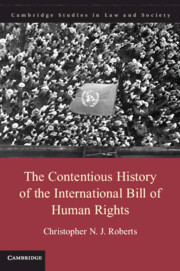Book contents
- Frontmatter
- Contents
- Preface
- Acknowledgments
- Introduction
- Chapter 1 What Are Human Rights and Where Do They Come from?
- Chapter 2 From War and Politics to Human Rights: The Cold War and Colonial Recession
- Chapter 3 Protecting State Sovereignty from the “Dangers” of Human Rights
- Chapter 4 Saving Empire: The Attempt to Create (Non)-Universal Human Rights
- Chapter 5 A Human Rights Treaty that Permits Lynching?
- Chapter 6 The United States’ Unequivocal Ambivalence toward Socioeconomic Rights
- Epilogue
- Index
- References
Chapter 5 - A Human Rights Treaty that Permits Lynching?
Published online by Cambridge University Press: 05 November 2014
- Frontmatter
- Contents
- Preface
- Acknowledgments
- Introduction
- Chapter 1 What Are Human Rights and Where Do They Come from?
- Chapter 2 From War and Politics to Human Rights: The Cold War and Colonial Recession
- Chapter 3 Protecting State Sovereignty from the “Dangers” of Human Rights
- Chapter 4 Saving Empire: The Attempt to Create (Non)-Universal Human Rights
- Chapter 5 A Human Rights Treaty that Permits Lynching?
- Chapter 6 The United States’ Unequivocal Ambivalence toward Socioeconomic Rights
- Epilogue
- Index
- References
Summary
Introduction
A prize is something worth winning. Although it is generally taken for granted that human rights are a good thing and worth fighting for, scholars have noted a persistent gap between the rhetoric and the reality of human rights. It is not uncommon for domestic violations to accompany a state’s support for international human rights treaties. Authoritarian leaders and repressive, nondemocratic regimes, for instance, often use the goodwill of human rights as “window dressing” to mask domestic abuses. If in fact human rights do not live up to their promises, then perhaps they are not the prize we have always assumed they are.
Chapter 5 examines the presence of one such gap between rhetoric and reality not in the developing world or a nondemocratic regime, as is often the focus of such analyses – but in the United States, where in the late 1940s and early 1950s human rights ideas such as nondiscriminationand racial equality collided dramatically with longstanding and widely accepted practices of racial exclusion. This chapter reveals that the protective capacity of rights – that is, what if anything they amount to in practice – exists not solely within the right. Whether moral principles, treaties, or enforcement mechanisms can have an effect depends first on a rights claimant’s membership within a broader collectivity. The realization of the rhetoric surrounding rights depends first on the outcome of an underlying struggle for a position within a group that is willing to fight on behalf of a claimant against a common threat, and the place of that group vis-à-vis other groups. A right is therefore not at its most basic essence a thing unto itself, but rather a representation of human relations. To neglect this dynamic obfuscates the crucial process and key variables that determine whether a rights claimant is fighting for a prize or for the rights of others.
- Type
- Chapter
- Information
- Publisher: Cambridge University PressPrint publication year: 2014

